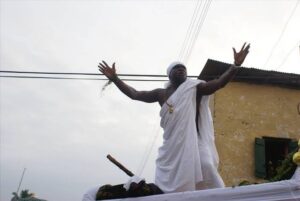
Fante women of Elmina (Edina) with their hairstyle in a wooden engraved drawing (1800-1895). Elmina was considered a ‘large’settlement when the Portuguese arrived.There is little indication of what this meant, but the population probably only numbered a few hundred. During the following four centuries, the town became one of the largest, if not the largest, settlement on the coast. This may already have been true by the late sixteenth century when Elmina, followed by Shama, was said to be larger than settlements in the coastal hinterland such as Efutu (Hair 1994:77 note 126). Harvey Feinberg (1989:85) estimates Elmina’s population as between 12,000 and 16,000 during much of the eighteenth century,while Larry Yarak (1990:48) suggests similar figures for the 1820s. During the late nineteenth century the number of inhabitants may have been somewhat higher. A Dutch report of 1859 estimated a total population between 18,000 and 20,000 (Feinberg 1989:95 note 42; see also Baesjou 1979:214–224; Kea 1982:32–39; Wartemberg 1951:14).
Maps of the coast by Luis Teixeirain 1602 and a Dutch manuscript of 1629 show Eguafo (Comendo) to the west of Elmina, while the country of Efutu (Fetu, Futu, Afutu) lies to the east as shown in Figure 2 (see Blake 1987; Cortesão and Teixeira de Mota 1960 vol.3:67–70; Daaku 1970:182–184; Daaku and Van Dantzig 1966;de Marees 1987[1602]; Kea 1982:23–28; and Müller cited in Jones 1983). Efutu controlled much of the coast east of Elmina as far as Cape Coast. The Dutch map further shows theEguafo Kingdom bordered by Abrem to the north-east, Adom to the north-west, and Yabiw and Ahanta to the west. This western border was linguistic as well as political (see Daaku and van Dantzig 1966; Hair 1969:229; Kea 1982:27). The relative positions of the polities seem to hold through the seventeenth century (see Roussier 1935:10).
These names, and possibly the lineal descendants of the polities represented, still exist (Chouin 2005
Elmina (now the principal town of the Edina State) only emerged as an independent polity after the advent of the Atlantic trade. European contact cannot be fully evaluated, it is clear that fifteenth-century Elmina was not an independent state. Prior to European contact the Eguafo and Efutu states may have both claimed territorial rights to Elmina. Some Elmina oral traditions recount the founder of Elmina was Kwa Amankwaa,a member of the Eguafo royal family who came to Elmina to hunt (Feinberg 1969:8–14; Fynn 1974b:3–4; Meyerowitz1952, 1974:76–77).

Support for Efutu claims, on the other hand, primarily come from documentary sources. The principal source is the Dutch map of 1629 (see Figure 2) that states “… in the old days one half [of Elmina] used to be under Great Commendo [Eguafo] and the other Futu [Efutu], who came there to collect their contribution” (see Daaku and Van Dantzig 1966; Feinberg 1969:12). This division is repeated in later sources. The Portuguese, and later the Dutch, at Elmina gave gifts to both kings of Eguafo and Efutu at various times(see Blake 1967[1942]:44-45; Fynn 1974b:4; Meyerowitz1952:70–73, 1974:76–80; Yarak 1986a